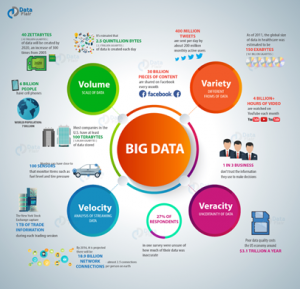Big data differs from regular data because big data uses distributed architecture. Which just means that data is gathered from several different computers within a network. Big data is important to businesses because it improves operations, customer service, and marketing, allowing them to make faster and more informed business decisions. Businesses can analyze real-time and historical data to assess the changes in preferences and enable the business to be more responsive to changes. Big data, it is characterized by something called “6Vs.” The 6 V’s include: volume, velocity, variety, veracity, value, and variability. Volume helps define big data because the volume is a large amount of data making it big data. Velocity refers to the high speed of the collection of data. When there is a large and continuous flow of data that helps us define the data as “big data.” The variety of big data can be broken down into 3 categories: structured data, semi-structured data, and unstructured data. Structured data is organized data, and semi-structured data does not have a formal structure. Unstructured data is data that does fit into any typical structure. Veracity is the uncertainty with data. With big data, there is data coming in different types of data coming from multiple sources. Value is what gives data its purpose. Data is useless unless you have a goal in collecting it. Variability is the changing shape of the data you collect. The “6 V’s” of data allows us to understand data and also apply these concepts to define if the data we collect is big data.
there is data coming in different types of data coming from multiple sources. Value is what gives data its purpose. Data is useless unless you have a goal in collecting it. Variability is the changing shape of the data you collect. The “6 V’s” of data allows us to understand data and also apply these concepts to define if the data we collect is big data.
Reader Interactions
Comments
Leave a Reply
You must be logged in to post a comment.
Hello Kristina,
I think that your post highlighted the main distinction between big data and data. Big data refers to the larger and more complex version of data. Big data receives mass volume, making it necessary to gather data from multiple computers within the same network. Big data consists of raw data, which is then analyzed at a much larger level to increase operation and customer service.